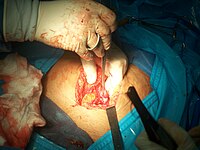
Photo from wikipedia
Objectives: To evaluate the pregnancy and delivery rates of laparoscopic tubal reanastomosis. Study Design: From 2003 to 2013, 135 laparoscopic tubal reversals were performed according to the four stitch technique.… Click to show full abstract
Objectives: To evaluate the pregnancy and delivery rates of laparoscopic tubal reanastomosis. Study Design: From 2003 to 2013, 135 laparoscopic tubal reversals were performed according to the four stitch technique. The parameters studied, included positive pregnancy test, miscarriage, ectopic pregnancy, termination of pregnancy, term delivery, post-operative time to conception, post-operative hysterosalpingography, and spermogram. Results: From the 135 patients operated, 93 fulfilled the inclusion criteria. The age of patients varied from 27 to 47 years old. All ages combined, positive β-HCG blood sample rate was 75.3% (95% CI: 65.0–83.4%) and term delivery 52.7% (95%CI: 42.1–3.0%). The age-adjusted pregnancy and delivery rates were as follows: 27–35 y.o. (n = 23) 95.7% (95%CI: 76.0–99.8%) and 73.9% (95%CI: 51.3–88.9%), 36–39 y.o. (n = 40) 77.5% (95%CI: 61.1–88.6%) and 47.5% (95%CI: 31.8–63.7%), 40–42 y.o. (n = 19) 68.4% (95%CI: 43.5–86.4%) and 52.6% (95%CI: 29.5–74.8%), 43–47 y.o. (n = 11) 36.4% (95%CI: 12.4–68.4%) and 27.3% (95%CI: 7.3–60.7%). Conclusions: In our series the pregnancy and delivery rates after laparoscopic reversal of tubal sterilization is estimated at 75.3 and 52.7%, respectively. For women with tubal sterilization and no other infertility factors, reanastomosis can restore anterior natural fertility related to age. Laparoscopic reversal should be proposed systematically to patients and performed by well-trained laparoscopists, avoiding potentially the inconvenient and adverse outcomes of an IVF treatment. Although, it may seem a more cost-effective technique compared to robotically assisted reversal, a prospective randomized trial could answer this question.
Journal Title: Frontiers in Surgery
Year Published: 2019
Link to full text (if available)
Share on Social Media: Sign Up to like & get
recommendations!